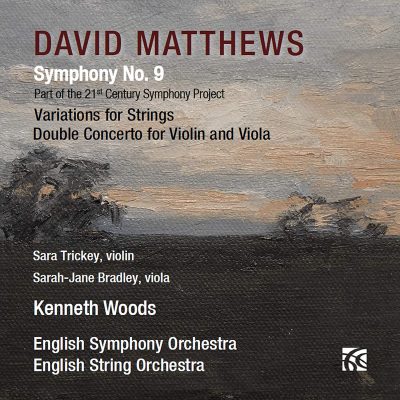Fanfare Magazine on Matthews Symphony No. 9
From the Nov/Dec 2019 issue of Fanfare Magazine
David Matthews (b. 1943) and his older brother Colin, also a composer, were assistants to Benjamin Britten during the late 1960s and early 1970s. I was unsure of the chronology, but David wrote to me via email, “Colin took over from me as Britten’s assistant in 1970 after I’d done the job for four years and Britten thought Colin—who had helped me with the Owen Wingrave full score—should now have his chance. Colin then worked for him until he died. I didn’t give up working for Britten, altogether as a few years later I helped him with the revised score for Paul Bunyan. Britten once asked my mother, ‘Are there any more of you?’” Since then, Matthews has produced a vast body of work in traditional forms, particularly a series of 14 string quartets and as of now nine symphonies, most of which have been recorded.
Like Shostakovich, Matthews decided against creating a monumental Ninth. This 2016 work in five movements is built on a carol he composed for his wife: a flowing, almost folk-like melody. The symphony has its dramatic moments—the Scherzo displays a Waltonian bite—but is generally lighter in intensity than some of his earlier symphonies, and more of a divertimento in the central movements. The delicate fourth movement, Ombroso, pits dancelike woodwinds against pizzicato strings, and the symphony closes in a flood of major key warmth. It is a sunny piece, but Matthews is a genuine symphonist nevertheless, squeezing every drop of developmental potential out of his theme. The Variations for Strings, on Bach’s chorale Die Nacht ist kommen, dates from 1986. Matthews’s English roots are clear in this lovely work, although he stretches the pastoral mood to incorporate a jazzy walking bass in the third variation. His mentor’s influence is at its strongest in the sparsely motivic writing, and as Britten did in his Lachrymae (a set of variations for viola and strings on Dowland’s song), Matthews places the solemn chorale theme at the end, adding only a brief Allegro coda.
The Double Concerto for Violin, Viola and Strings of 2013 is another attractive work in the composer’s Modernist-pastoral vein, but more sprightly than the Variations. The concerto is designed primarily to show off the skills and rapport of the two soloists. This performance from Trickey and Bradley scores highly in both respects. The English String Orchestra (which may well be an expanded version of the string sections of the English Symphony Orchestra) plays with passionate commitment, as does the full orchestra in the Ninth Symphony, and Kenneth Woods’s conducting credentials are well established on disc. Sound is vivid and well balanced.
This recording of the symphony is part of a Woods initiative called The 21st Century Symphony Project. The plan is to commission, perform and record nine new symphonies by British composers. The project was launched in 2016 with the Symphony No. 3 by Philip Sawyers (who is the English Symphony Orchestra’s current Composer in Association). I don’t know the Sawyers symphony, but in Fanfare 41:3 Gavin Dixon called it “a major new work from a distinctive voice in British music.” The next to appear will be Symphony No. 5 by Matthew Taylor, a composer whose work I have reviewed favorably in Fanfare before. Taylor’s new piece had its premiere last year. If David Matthews’s Ninth is any indication, the project is producing music of lasting value. Phillip Scott


